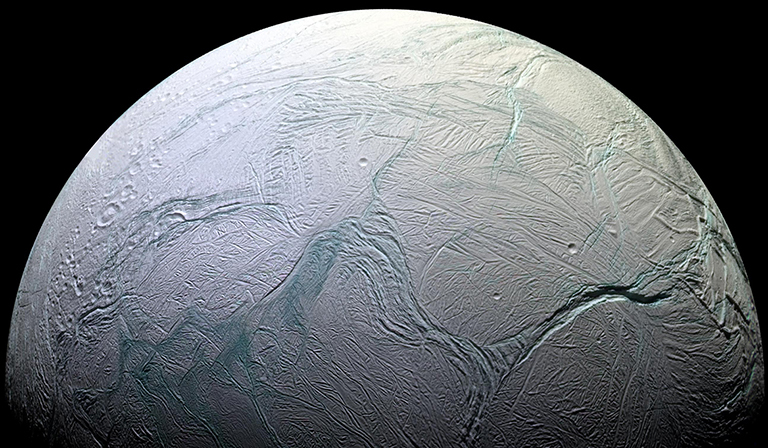By Leonard David, Space.com's Space Insider Columnist |

BOULDER, Colo. — NASA's Cassini mission to Saturn has
transformed scientists' understanding of the ringed planet and its
retinue of icy moons.
For example, Cassini discovered that the Saturn satellite Enceladus is a mini-world of active jets — geyser-like phenomena that blast out water vapor and ice particles from the huge, salty ocean that lies beneath the moon's icy crust.
It's no wonder, then, that Enceladus has become a magnet of sorts in the search for life beyond Earth. [Photos: Enceladus, Saturn’s Cold, Bright Moon]
A conference called "Enceladus and the Icy Moons of Saturn" was held here from July 26 through July 29, bringing together top experts to the first major international conference devoted specifically to Enceladus and Saturn’s family of super-chilly moons.
The event was supported by the Universities Space Research Association and the Lunar and Planetary Institute in Houston.
"The jets must be supersonic, with Mach numbers of two or greater, but because of cooling of the water vapor in the eruption throat, the actual velocity may not be as high as we thought previously," said Larry Esposito, a conference organizer and a professor of astrophysical and planetary sciences in the Laboratory for Atmospheric and Space Physics (LASP) at the University of Colorado, Boulder. "But it's still greater than one kilometer per second … and that's faster than a speeding bullet!"
Cassini flew by Enceladus for the last time in October 2015. (After almost 20 years in space, the $3.2 billion Cassini mission is set to end in September 2017.)
The information Cassini gathered during these passes strongly suggests that Enceladus harbors a large ocean beneath its icy shell, and that this ocean might be able to support life as we know it, mission team members have said. (The ocean stays liquid because of "tidal heat" created by the tug of Saturn's powerful gravity.)
"Enceladus possesses habitable locales, but does it contain life?" Esposito told Space.com.
Scientists around the world are considering a variety of ways to tackle this question. [6 Most Likely Places for Alien Life in the Solar System]
For example, Cassini discovered that the Saturn satellite Enceladus is a mini-world of active jets — geyser-like phenomena that blast out water vapor and ice particles from the huge, salty ocean that lies beneath the moon's icy crust.
It's no wonder, then, that Enceladus has become a magnet of sorts in the search for life beyond Earth. [Photos: Enceladus, Saturn’s Cold, Bright Moon]
A conference called "Enceladus and the Icy Moons of Saturn" was held here from July 26 through July 29, bringing together top experts to the first major international conference devoted specifically to Enceladus and Saturn’s family of super-chilly moons.
The event was supported by the Universities Space Research Association and the Lunar and Planetary Institute in Houston.
Habitable locales
Cassini has performed many flybys of Enceladus since arriving in the Saturn system in July 2004, sometimes even cruising through the plumes generated by the geysers, which erupt from "tiger stripe" fissures near the moon’s south pole."The jets must be supersonic, with Mach numbers of two or greater, but because of cooling of the water vapor in the eruption throat, the actual velocity may not be as high as we thought previously," said Larry Esposito, a conference organizer and a professor of astrophysical and planetary sciences in the Laboratory for Atmospheric and Space Physics (LASP) at the University of Colorado, Boulder. "But it's still greater than one kilometer per second … and that's faster than a speeding bullet!"
Cassini flew by Enceladus for the last time in October 2015. (After almost 20 years in space, the $3.2 billion Cassini mission is set to end in September 2017.)
The information Cassini gathered during these passes strongly suggests that Enceladus harbors a large ocean beneath its icy shell, and that this ocean might be able to support life as we know it, mission team members have said. (The ocean stays liquid because of "tidal heat" created by the tug of Saturn's powerful gravity.)
"Enceladus possesses habitable locales, but does it contain life?" Esposito told Space.com.
Scientists around the world are considering a variety of ways to tackle this question. [6 Most Likely Places for Alien Life in the Solar System]